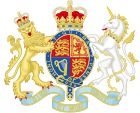- Ministers of the Crown Act 1937
-
Ministers of the Crown Act 1937 
Parliament of the United KingdomStatute book chapter C.38 Dates Repeal date 1965 Other legislation Repealing legislation Ministerial Salaries Consolidation Act 1965 Status: Repealed The Ministers of the Crown Act 1937 (C.38) was an Act of the Parliament of the United Kingdom that set salaries for members of the Government and Opposition. It is notable as the first Act to formally recognise the Prime Minister of the United Kingdom and the Cabinet.
Act
The Act set out salaries for Government ministers and certain members of the Opposition. Although applying to "ministers" it did not define ministers and indeed excluded two of them: the Lord Chancellor and Attorney General for England and Wales. The Act first gave the salary for the Prime Minister of the United Kingdom, which was set at £10,000 a year.[n 1] This was only the second time that the Prime Minister had been mentioned in an Act of Parliament, after the Chequers Estate Act 1917, which granted him a country residence at Chequers.[1]
The other officials covered by the Act fell into two categories – heads of department, and under-secretaries. Heads of certain departments, such as the Chancellor of the Exchequer, received £5,000[n 2] a year regardless of their membership in the Cabinet, while others such as the Lord Privy Seal received £3,000,[n 3] with an increase to £5,000 if they come to sit in the Cabinet. The under-secretaries were granted £3,000 a year if Chief Whip, £2,000[n 4] if Financial Secretary to the Treasury, £1,500[n 5] if Financial Secretary to the Admiralty or similar and £1,000[n 6] if Assistant Postmaster-General. The Act also gave a pension of £2,000 a year to any individual who had served as Prime Minister, and a salary of £2,000 to the Leader of the Opposition.[2]
The Act is notable for several reasons; it was the first Act of Parliament to directly deal with ministerial salaries, and also the first Act to provide a salary for the Prime Minister,[3] and for the Leader of the Opposition. As well as being only the second time the Prime Minister has been mentioned in a statute, the Act was also the first statute to recognise the Prime Minister, and the Cabinet.[4] The Act was repealed by the Ministerial Salaries Consolidation Act 1965.[5]
Notes and references
- Notes
UK CPI inflation numbers based on data available from Measuring Worth: UK CPI
- ^ £10,000 in 1937 would be worth approximately £478,000 as of 2011
- ^ £5,000 in 1937 would be worth approximately £239,000 as of 2011
- ^ £3,000 in 1937 would be worth approximately £143,000 as of 2011
- ^ £2,000 in 1937 would be worth approximately £96,000 as of 2011
- ^ £1,500 in 1937 would be worth approximately £72,000 as of 2011
- ^ £1,000 in 1937 would be worth approximately £48,000 as of 2011
- References
- ^ W.I.K. (1937) p. 145
- ^ W.I.K. (1937) p. 146
- ^ Brazier (1997) p. 91
- ^ Mowat (1978) p. 634
- ^ "Lexis@Library: Document (subscription needed)". LexisNexis. http://www.lexisnexis.com/uk/legal/docview/getDocForCuiReq?oc=00240&lni=4ST8-CMY0-TWPY-Y1HJ&csi=274768&secondRedirectIndicator=true. Retrieved 2009-10-27.
Bibliography
- Brazier, Rodney (1997). Ministers of the Crown. Oxford University Press. ISBN 0198259883.
- Mowat, Charles Loch (1978). Britain between the wars: 1918–1940. Taylor & Francis. ISBN 041629510X.
- W.I.K. (1937). "Ministers of the Crown Act 1937". Modern Law Review (Blackwell Publishing) 1 (2). ISSN 0026-7961.
Categories:- United Kingdom Acts of Parliament 1937
- Government of the United Kingdom
- Repealed United Kingdom Acts of Parliament
Wikimedia Foundation. 2010.
